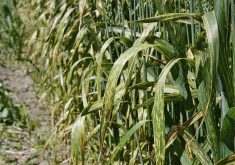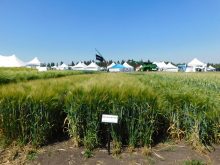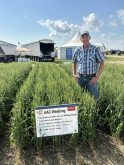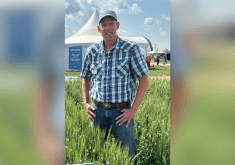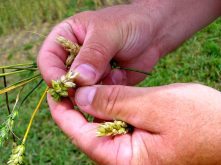Although it’s likely too late to apply a fungicide for fusarium graminearum, producers can still use the information they gather about the outbreak to plan for subsequent growing seasons.
Fusarium graminearum is considered the most important fusarium head blight (FHB) species due to its aggressiveness and production of deoxynivalenol or DON (a.k.a. vomitoxin), said crop specialist Neil Whatley.
To limit impact, farmers should use a combination of disease prevention strategies throughout the growing season, he said.
“The first step to trying to limit FHB is knowing whether the disease is present in a field by searching for and observing disease symptoms,” he said. “Additionally, learning whether fusarium graminearum is the dominant FHB species under observation, and becoming aware of its prevalence and severity, contributes to this first step toward potentially reducing its impact.”
Read Also

Hail research hopes to benefit potato growers
Alberta research scientist measures hail storm and heat dome affects on potato crops
FHB symptoms appear during the heading stage, typically once the plant reaches late milk to early dough during the last part of July or early August. The most apparent disease symptom in wheat is premature bleaching of one or more infected spikelets in the cereal plant’s head, which visibly stands out on green heads. Rain-splashed spore growth appears as an orange, pink or salmon-coloured fungal growth at the base and edges of the glumes on these blighted head parts. Symptoms in barley are much less distinct and the brownish discolouration due to FHB can be easily confused with hail damage, or symptoms of net blotch or spot blotch infection.
Diseased spikelets can contain visibly affected kernels. In grading terms, visibly affected wheat seeds are called fusarium-damaged kernels (FDK), whereas in barley, it is called fusarium mould. FDKs in wheat are shrunken and are typically a chalky white colour, while fusarium mould on barley appears as an orange or black encrustation of the seed surface. Symptoms in barley may be confused with hail damage, kernel smudge, or infection by leaf diseases (such as net blotch or spot blotch).
“Infection timing determines the severity of kernel damage,” said Whatley. “While infection occurring at early flowering can lead to complete abortion of kernels, FDKs generally result from infection from the early- to mid-flowering stages. Late infections well after flowering and up to the soft-dough stage of kernel development may not show visible symptoms. However, kernels can contain the fungus and, more importantly, the mycotoxin it produces.”
If any symptoms are observed, send the affected cereal head samples to a lab to determine whether the species is indeed fusarium graminearum and its prevalence.
“Routine testing of harvested grain and seed intended for planting is another way of assessing the presence and extent of fusarium graminearum, especially if harvested grain is downgraded due to the presence of FDK,” said Whatley. “Several private seed company labs offer testing services for fusarium graminearum in cereal seed/grain.”
If fusarium graminearum is not found in plant, grain or seed samples, producers should be cautious about their seed source and ensure that they limit their exposure to this pathogen via infected seed, he said.
“This is less of a concern where the pathogen is well established on crop residues from previous growing seasons. Ultimately, determining the need for a fungicide application in an area where fusarium graminearum is established will largely depend on the occurrence of moderate temperatures and suitable moisture just prior to and during the early stages of flowering.”



